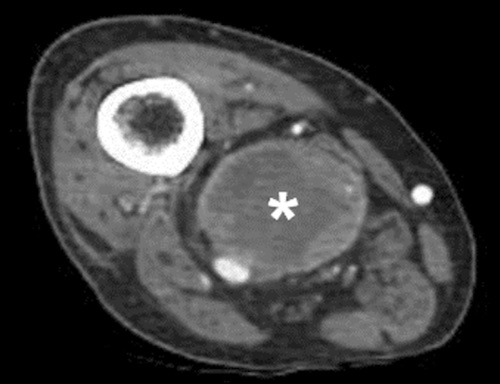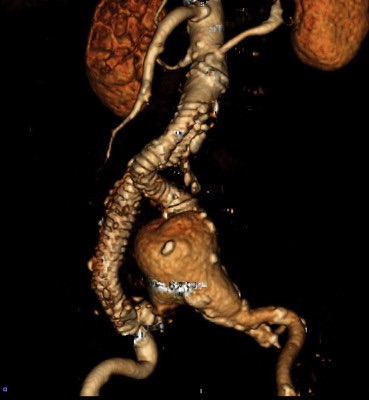Vascular: Peripheral Aneurysm
Lower Extremity Aneurysm
Basics
- Definition: Arterial Dilation to 1.5 Times the Normal Diameter
- True Aneurysms are More Common in Men (30:1)
- Many Have Bilateral Aneurysms or Other Aneurysms Throughout the Body
- Most Common Complication: Thrombosis #1 & Emboli
- Not Rupture as in Visceral
Presentation
- Many Are Asymptomatic (30-40%)
- Lower Extremity Ischemia & Intermittent Claudication (65%) – Most Common Presentation
- Usually Due to Thrombosis or Embolization
- Localized Pain
- Compressive Symptoms (Edema & Neuropathic Pain)
Sites
- Iliac Artery Aneurysm
- Most Are Associated with a Current or Past AAA (86%)
- Common Iliac Artery Most Common (70%)
- 50-65% Are Bilateral
- Femoral Artery Aneurysm
- Location:
- Common Femoral Artery (57-81%) – Most Common
- Superficial Femoral Artery (14-26%)
- Profunda Femoral Artery (5-17%)
- 26% are Bilateral
- 48% Have Additional Aneurysms Elsewhere
- Location:
- Popliteal Artery Aneurysm
- Most Common Peripheral Artery Aneurysm
- 50% Are Bilateral
- 50% Have Additional Aneurysms Elsewhere
Diagnosis
- Duplex US or CTA/MRA
- Consider Screening for Other Aneurysms as Well
Treatment Indications
- Symptomatic
- Large Size:
- Iliac: > 3.0-3.5 cm
- Femoral:
- CFA: > 3.5 cm
- *Previously was 2.5 cm
- SFA: > 2.5 cm
- PFA: Repair All
- CFA: > 3.5 cm
- Popliteal: > 2.0 cm
- *Generally Consider a Reduced Cutoff if Intraluminal Thrombus Present
- Rupture
Treatment
- Iliac Arteries: Endovascular Stenting
- Open Surgical Repair if Anatomy Not Amenable or if Internal Iliac Artery Patency is Essential
- Surgical Access More Difficult with Higher-Risks
- Femoral Arteries: Surgical Exclusion with Interposition Bypass
- Prosthetic Grafts Preferred Over Veins – Better Size Match & Patency Rates
- Consider Endovascular Stenting if Multiple Comorbidities Create High Surgical Risk
- Popliteal Artery: Surgical Exclusion with Interposition Bypass
- Medial or Posterior Approaches
- Endovascular Repair is Evolving

Popliteal Aneurysm 1

Iliac Aneurysm 2
Upper Extremity Aneurysm
Basics
- Definition: Arterial Dilation to 1.5 Times the Normal Diameter
- Much Less Common than Lower Extremity Aneurysms
- Most Common Site: Aortic Arch Vessels
Presentation
- Many Are Asymptomatic
- Ischemia & Intermittent Claudication
- Localized Pain
- Compressive Symptoms
- Brachial Plexus – Arm Pain or Neurologic Dysfunction
- Recurrent Laryngeal Nerve – Hoarseness
- Esophagus – Dysphagia
Sites
- Aortic Arch Vessel Aneurysm
- Most Common: Subclavian Artery
- Axillary Artery Aneurysm
- Usually from Trauma
- Most Common in Young Athletic Men (Baseball Pitchers)
- Brachial Artery Aneurysm
- Less Common than Pseudoaneurysms from Repetitive Trauma/Iatrogenic Injury
Diagnosis
- Duplex US or CTA/MRA
Treatment
- Indications: In General, All Upper Extremity Aneurysms Should Be Repaired
- Preferred Tx: Surgical Resection & Interposition Graft
- Endovascular Repair is Evolving

Left Subclavian Artery Aneurysm 3
References
- Chetouani A, Perrin M, Drouet C, Marie PY, Verger A. Aneurysmal angiosarcoma associated with vascular graft revealed by 18F-FDG-PET imaging. Radiol Case Rep. 2017 Jan 30;12(2):413-415. (License: CC BY-NC-ND-4.0)
- Kordzadeh A, Scott H, Railton N, Panayiotopoulos YP. Aneurysmal degeneration and type Ib endoleak with proximal aneurysm rupture: A case report, review of literature and technical suggestions. Ann Med Surg (Lond). 2014 Mar 5;3(2):43-6. (License: CC BY-NC-ND-3.0)
- Pogorzelski R, Wołoszko T, Toutounchi S, Fiszer P, Krajewska E, Jakuczun W, Szostek MM, Celejewski K, Gałązka Z. Intravascular Treatment of Left Subclavian Artery Aneurysm Coexisting with Aortic Coarctation in an Adult Patient. Open Med (Wars). 2017 Mar 23;12:1-4. (License: CC BY-NC-ND-3.0)